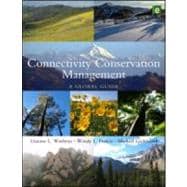
Note: Supplemental materials are not guaranteed with Rental or Used book purchases.
Purchase Benefits
What is included with this book?
| List of Figures, Tables and Boxes | p. xii |
| Acknowledgements | p. xvii |
| Preface | p. xxiii |
| Foreword | p. xxv |
| List of Acronyms and Abbreviations | p. xxvii |
| Glossary | p. xxix |
| Setting the Context | p. 1 |
| The Connectivity Conservation Imperative | p. 3 |
| About connectivity conservation | p. 3 |
| Planning context | p. 8 |
| A global initiative | p. 8 |
| Potential connectivity conservation areas | p. 10 |
| Forecast futures | p. 11 |
| Four scenarios | p. 12 |
| An imperative for connectivity conservation | p. 17 |
| Origins, purpose and structure of this book | p. 18 |
| Connectivity Science | p. 22 |
| Island biogeography, metapopulation theory and landscape ecology | p. 26 |
| Scientific debate over the value of corridors | p. 28 |
| Connectivity conservation and climate change | p. 31 |
| Conclusion | p. 33 |
| Scoping the Territory: Considerations for Connectivity Conservation Managers | p. 34 |
| Natural considerations | p. 34 |
| Institutional considerations | p. 37 |
| Financial considerations | p. 43 |
| Social and individual considerations | p. 45 |
| Conclusion | p. 51 |
| Applied Connectivity Conservation Management: Case Material | p. 53 |
| Africotropical Connectivity Conservation Initiatives | p. 55 |
| Joining the dots; Stewardship for connectivity conservation in the Cederberg Mountains, Cape Floristic Region, South Africa | p. 55 |
| Conserving connectivity in the Greater Virunga Landscape | p. 69 |
| Maloti-Drakensberg Transfrontier Conservation and Development Programme: A South African perspective | p. 77 |
| Australian Connectivity Initiatives | p. 86 |
| Australian Alps national parks: Enhancing connectivity through cooperation across borders | p. 87 |
| Australian Alps to Atherton connectivity conservation | p. 96 |
| Ecological restoration in Gondwana link (south-western Australia): A convergence of thought and action | p. 105 |
| Indomalayan Connectivity Initiatives | p. 116 |
| Creating biological corridors for conservation and development: A case study from Bhutan | p. 117 |
| Developing conservation corridors and regional cooperation in the transboundary Sacred Himalayan Landscape | p. 124 |
| Establishing tropical rainforest connectivity in northern Sumatra: Challenges and opportunities | p. 133 |
| Nearctic Connectivity Initiatives | p. 140 |
| Conservation network in the southern Appalachian mountains | p. 140 |
| Greater northern Appalachian bioregion | p. 152 |
| Yellowstone to Yukon connectivity conservation initiative | p. 161 |
| Neotropical Connectivity Initiatives | p. 182 |
| Mesoamerican biological corridor | p. 183 |
| Ecosystem approach applied to international connectivity: The Andean | p. 191 |
| Integrating protected areas and landscapes: Lessons from the Vilcabamba-Amboro conservation corridor (Bolivia-Peru) | p. 199 |
| Serra do Espinhaço Biosphere Reserve | p. 211 |
| Articulating local visions to build macro-corridors: The Munchique-Pinche example | p. 221 |
| Llanganates-Sangay ecological corridor, Ecuador: Good conservation practice at a local scale | p. 226 |
| Implementation of an interconnected system of protected areas in the Venezuelan Andes | p. 234 |
| Palaearctic Connectivity Initiatives | p. 245 |
| Altai Mountain Knot: Between conservation and development | p. 246 |
| Overview of connectivity projects in the European Alps and adjacent mountains | p. 250 |
| Tri-national Mont-Blanc Massif: A crucial link in European alpine connectivity | p. 258 |
| Ecological network of protected areas in the European Alps | p. 264 |
| Cantabrian Mountains-Pyrénées-Massif Central-Western Alps Great Mountain corridor | p. 269 |
| The Appenines (European Alps to the Mediterranean) | p. 279 |
| Themes and Lessons from Global Experience in Connectivity Conservation | p. 283 |
| Lessons from the Papallacta workshop | p. 283 |
| From practice to conceptual framework | p. 292 |
| Conclusion | p. 298 |
| Synthesis | p. 299 |
| Connectivity Conservation Management Framework and Key Tasks | p. 301 |
| Components of a management framework | p. 301 |
| The management framework | p. 307 |
| Connectivity conservation management tasks | p. 309 |
| Challenges and Opportunities for Connectivity Conservation | p. 342 |
| References | p. 347 |
| Index | p. 373 |
| Table of Contents provided by Ingram. All Rights Reserved. |
The New copy of this book will include any supplemental materials advertised. Please check the title of the book to determine if it should include any access cards, study guides, lab manuals, CDs, etc.
The Used, Rental and eBook copies of this book are not guaranteed to include any supplemental materials. Typically, only the book itself is included. This is true even if the title states it includes any access cards, study guides, lab manuals, CDs, etc.